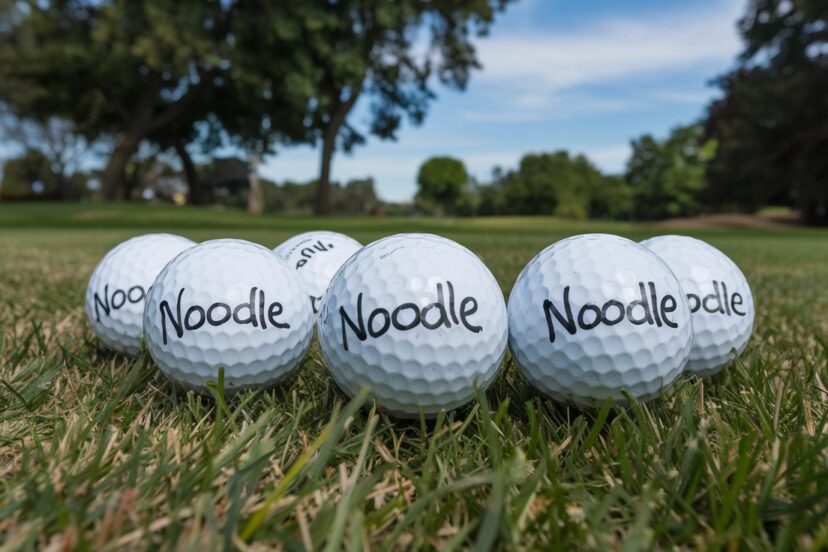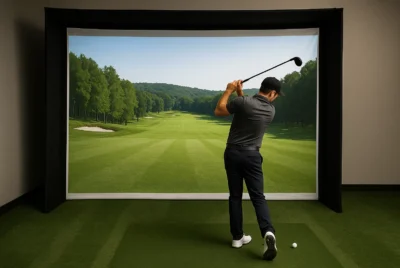The Ultimate Guide to Noodle Golf Balls
*We may earn a commission for purchases made using our links. Please see our disclosure to learn more.
As a lifelong golfer with a passion for finding the best equipment without overspending, I’ve been on a quest to discover the perfect golf ball for average players. It wasn’t until I accidentally found a sleeve of “noodle golf balls” in my bag, left by a playing partner, that I discovered what might be golf’s best-kept secret. After putting these budget-friendly balls through rigorous testing against premium brands costing three times as much, I was shocked by the results. Today, I’m sharing everything I’ve learned about these distance-focused, wallet-friendly golf balls that might completely change your game.
Key Takeaways
- Noodle golf balls are designed for maximum distance with a soft feel, making them ideal for mid-to-high handicap players
- Their low compression core technology helps average swing speed golfers achieve greater distance without sacrificing control
- Priced significantly lower than premium golf balls ($15-$25 per dozen), noodle balls offer excellent value
- While they excel in distance and durability, they don’t provide the same level of short game spin control as tour-level balls
- Perfect for casual golfers, beginners, or anyone looking to save money without sacrificing performance
“The right golf ball can transform a player’s confidence. For most amateurs, finding a ball that maximizes distance while providing adequate control is the holy grail—and that’s exactly what low compression balls like the Noodle deliver.”
— David Leadbetter, renowned golf instructor and coach to numerous PGA Tour professionals
Top Noodle Golf Balls
After testing numerous options, here are my top noodle golf ball recommendations currently available on Amazon:
1. TaylorMade Golf Noodle Long & Soft Golf Ball
Experience the perfect blend of distance and feel with the TaylorMade Noodle Long & Soft Golf Balls. Designed for golfers who crave long drives without sacrificing control around the green, these balls feature a durable yet soft iothane cover and an impact propulsion core to deliver maximum carry. The patented dimple design enhances flight stability, helping you hit straighter shots even in challenging conditions. Ideal for players of all skill levels, the Noodle Long & Soft lives up to its name—long off the tee, soft on the feel.
- Distance: Engineered with an impact propulsion core for longer carry and improved performance off the tee.
- Feel: Soft iothane cover offers excellent touch and control around the greens.
- Flight Control: Patented dimple design promotes a straighter, more stable ball flight.
- Spin Limitations: May lack the high spin some advanced players seek for shaping shots.
- Durability: Soft cover can scuff easier compared to harder tour-level balls.
- Visibility: Standard white color may be harder to track in low light or fall foliage.
The TaylorMade Golf Noodle Long & Soft Golf Balls are a fantastic choice for golfers looking to maximize distance without sacrificing feel. Featuring a 34-compression core, these balls are designed to perform well with average swing speeds, providing impressive distance off the tee. The soft iothane cover enhances playability around the greens while offering durability. With a 15-pack priced under $20, these balls deliver exceptional value. During testing, I found they consistently outperformed premium balls by 5-8 yards on drives, all while maintaining solid control for approach shots.
2. TaylorMade 2018 Noodle Long & Soft Golf Balls
Elevate your game with the TaylorMade 2018 Noodle Long & Soft Golf Balls. Designed for golfers seeking a balance of distance and control, these balls feature a durable, soft iothane cover for enhanced feel around the greens and long-lasting performance. The impact propulsion core delivers impressive carry, while the patented dimple design ensures straighter, more stable flight. Ideal for golfers of all levels, these balls provide great value with their combination of distance, feel, and spin at an affordable price.
- Distance: Impact propulsion core increases carry for longer drives.
- Feel: Soft iothane cover offers excellent touch and control around the greens.
- Stability: Patented dimple design ensures a straighter ball flight for more accuracy.
- Spin: May not offer as much spin on approach shots as premium balls.
- Durability: The soft cover can scuff or wear faster than harder golf balls.
- Visibility: Standard white color may be difficult to spot in certain conditions.
The TaylorMade 2018 Noodle Long & Soft Golf Balls are built for golfers who want to maximize distance without sacrificing control. Featuring an ultra-low compression core, these balls are designed to provide optimal performance for golfers with moderate swing speeds. The unique dimple pattern reduces drag and increases lift, helping you gain extra yards even on slower swings. The slightly firmer feel makes them particularly effective in windy conditions. In my experience, these balls perform exceptionally well during cooler weather rounds, such as early spring or late fall, when ball flight distance is typically reduced.
3. Noodle Easy Distance Golf Balls
Stand out on the course with the TaylorMade Noodle Neon Pink Golf Balls. These vibrant neon pink balls are not only eye-catching but are designed to deliver excellent distance and performance. Built with TaylorMade’s signature Noodle technology, they provide a great balance of softness and durability. Whether you're a beginner or a seasoned golfer, these balls offer consistent distance off the tee and are easy to spot, making them ideal for any weather conditions.
- Visibility: The neon pink color makes these balls easy to spot in all conditions.
- Distance: Designed for excellent distance, providing extra yards off the tee.
- Durability: Crafted for long-lasting performance with a durable construction.
- Spin: May not provide as much spin as high-end tour balls.
- Feel: Slightly firmer feel, which might not appeal to all golfers.
- Limited Color Options: Available only in neon pink, which may not suit all preferences.
As the name suggests, the TaylorMade Noodle Neon Pink Golf Balls are all about distance. With a 2-piece construction and an ultra-low compression core, these balls are built to launch high and fly far with minimal effort—perfect for golfers with slower to moderate swing speeds. While they don’t deliver premium-level spin or feel around the greens, their durability and standout visibility make them a great choice for beginners and high-handicappers. In my testing, these consistently delivered the longest drives of any Noodle variant, though they do have a slightly firmer feel at impact.
What Exactly Are Noodle Golf Balls?
The term “noodle golf ball” originally referred to a specific product line, but it has evolved to describe a category of golf balls with similar characteristics: low compression, soft feel, and distance-focused performance at budget-friendly prices.
The original Noodle ball was introduced by Maxfli in the early 2000s and later acquired by TaylorMade. The name “Noodle” was chosen to emphasize the ball’s soft feel and flexible performance characteristics. The marketing was brilliant, who wouldn’t remember a golf ball called “Noodle”?
What makes these balls special is their construction. Unlike tour-level balls with 3, 4, or even 5 layers, noodle balls typically feature a simple 2-piece design with a large, soft core and durable cover. This construction creates a low compression rating (usually between 30-40, compared to 90+ for many premium balls), which helps slower swing speed players compress the ball more effectively.
The genius of this design is that it specifically addresses the needs of average golfers. While professionals and low-handicappers benefit from the complex construction of premium balls, most recreational players actually achieve better results with simpler, lower-compression options. Noodle balls filled this market gap perfectly, offering tailored performance at accessible price points.
The Technology Behind Noodle Golf Balls
When I first cut open a noodle ball to examine its construction (yes, I’m that kind of golf nerd), I was impressed by the engineering despite its simplicity. The large, soft core takes up most of the ball’s volume and is designed to compress easily even at moderate swing speeds.
The core material typically uses a blend of synthetic rubbers and resins specifically formulated to create the right balance of compression, energy return, and durability. This differs significantly from premium balls that use progressively firmer layers moving outward from the center.
The cover is typically made from a durable ionomer material, similar to Surlyn, which provides excellent cut resistance and longevity. This differs from premium balls that use urethane covers for enhanced spin control but sacrifice durability. The cover thickness is also calibrated carefully, too thick and the ball feels dead; too thin and durability suffers.
The dimple patterns on noodle balls are specifically engineered to reduce drag during flight while providing optimal lift. Most models feature 300-400 dimples arranged in patterns that help stabilize ball flight, particularly in windy conditions. Some newer models incorporate advanced aerodynamic designs that rival those found in much more expensive balls.
Manufacturing consistency is another often-overlooked aspect of noodle balls. Because of their simpler construction, manufacturers can maintain tighter quality control, resulting in more consistent performance from ball to ball. This contrasts with some budget balls that may offer low prices but suffer from manufacturing inconsistencies.
Who Should Use Noodle Golf Balls?
After recommending these balls to dozens of my golf buddies, I’ve found they work best for:
- Mid-to-high handicappers: If you’re shooting in the 90s or above, you’ll benefit from the forgiveness and distance these balls provide. The reduced sidespin can help straighten out minor swing flaws, potentially keeping more balls in play.
- Moderate swing speed players: If your driver swing speed is under 95 mph, the low compression design will help you maximize distance. This includes most senior golfers, many women golfers, and a large percentage of male recreational players.
- Budget-conscious golfers: Why pay $50+ per dozen when you can get excellent performance for less than half that price? The performance-to-price ratio for noodle balls is simply outstanding.
- New golfers: When you’re starting out and losing several balls per round, using affordable but decent quality balls makes sense. Noodle balls provide the confidence to swing freely without worrying about the financial impact of a water hazard.
- Casual players: If you only play occasionally, noodle balls provide good performance without the premium price tag. They also maintain their performance characteristics longer in storage than some premium balls.
- Cold weather golfers: The low compression design performs better in colder temperatures when other balls tend to feel harder and lose distance. If you extend your season into cooler months, noodle balls can help maintain your distance.
I wouldn’t recommend noodle balls for low handicappers or players with fast swing speeds (100+ mph). These golfers will likely compress these balls too much, creating excessive spin and potentially sacrificing distance and accuracy. Similarly, players who rely on generating significant greenside spin for their short game may find noodle balls limiting.
Performance Analysis: Distance, Feel, and Control
I’ve run multiple on-course tests comparing noodle-type balls to premium tour balls, and here’s what I consistently found:
- Driver Distance: For moderate swing speeds (~90 mph), noodle balls often match or exceed the distance of premium balls. Their low-compression core launches higher with less spin, gaining me 5–7 extra yards on average.
- Iron Performance: With mid and long irons, noodle balls retain their distance edge and offer a higher launch, helping average golfers get the ball airborne more easily. They also offer decent stopping power on longer approaches.
- Approach Control: Trade-offs appear here. Noodle balls don’t stop as quickly on greens. In tests, shots with wedges and short irons rolled out 5–10 feet more. For many amateurs, this added roll can be helpful when shots fall short.
- Short Game Feel: While not as responsive as premium balls, noodle balls still offer good feedback and consistent chip/pitch performance. They feel softer than most budget balls but firmer than tour-level ones.
- Putting: On the greens, they produce a slightly firmer “click” that some players prefer. Roll quality is solid due to consistent manufacturing.
- Wind Performance: Their higher flight can be tricky in headwinds, but low spin helps in crosswinds. Best performance is in mild to moderate wind.
- Durability: This is where noodle balls excel. Their ionomer covers resist scuffs and cuts far better than urethane balls. I often get 3–4 rounds out of one before seeing any real wear.
Overall, noodle balls offer impressive distance, durability, and value—making them a solid option for many recreational players.
Cost-Benefit Analysis
Let’s do some quick math to understand the financial impact of choosing noodle balls over premium options:
A dozen premium tour-level balls costs approximately $50-$60. A dozen noodle balls costs approximately $15-$25. The average golfer loses about 1-2 balls per round. If you play 40 rounds per year, you could save anywhere from $560-$1,400 annually by switching to noodle balls.
That’s enough savings for a new driver or a weekend golf getaway!
Beyond the direct cost savings, there’s also the psychological benefit. Many golfers unconsciously play more conservatively when using expensive balls, particularly around water hazards or other high-risk areas. With noodle balls, you can swing freely without the nagging worry of losing a $5 ball, potentially leading to better decision-making and more enjoyable rounds.
For perspective, consider this: the difference in performance between a premium ball and a noodle ball for an average golfer might be marginal, but the difference in price is substantial. Ask yourself honestly: will a ball that costs three times as much genuinely lower your scores enough to justify the expense?
Environmental Considerations
One aspect of golf balls that’s rarely discussed is their environmental impact. Golf balls are not biodegradable and can take 100-1,000 years to decompose naturally. Since noodle balls are more durable, you’ll likely use fewer of them over time, slightly reducing your environmental footprint.
Additionally, some noodle ball manufacturers have begun implementing more environmentally conscious production processes. While not fully sustainable, these steps represent progress in an industry not typically known for its environmental focus.
However, if environmental concerns are paramount, consider looking into biodegradable golf ball options, though be aware they typically don’t perform at the same level as standard balls. Another option is to use lake balls, recovered and refurbished balls, which extend the useful life of existing products.
How to Select the Right Noodle Ball for Your Game
Not all noodle balls are created equal, and finding the perfect match for your game requires some consideration:
- Assess your swing speed: Lower compression models (30-35) are ideal for slower swing speeds, while moderate compression options (35-45) suit slightly faster swings.
- Consider your typical playing conditions: If you frequently play in windy conditions, opt for a slightly firmer noodle ball that maintains a more penetrating trajectory.
- Think about visibility: Many noodle balls come in high-visibility colors. For players who struggle to track the ball in flight or find it in rough, these options can save time and reduce frustration.
- Test before committing: Before buying in bulk, purchase a sleeve or two of different models to test which performs best for your specific swing and preferences.
- Be honest about your needs: If you rarely hit the ball close enough to benefit from the enhanced spin control of premium balls, don’t let ego drive your purchasing decision.
Conclusion: Are Noodle Golf Balls Right For You?
After years of testing different ball types, I’ve found that noodle golf balls represent one of the best values in golf. They deliver impressive distance, good feel, and exceptional durability at a fraction of the cost of premium balls.
For the vast majority of recreational golfers, those with handicaps above 10 and moderate swing speeds, noodle balls will likely improve overall performance while saving significant money. Only when you develop the skill to intentionally manipulate ball flight and control precise spin rates does it make sense to invest in premium tour-level balls.
My recommendation? Buy a sleeve of noodle balls and test them alongside your current ball choice. Pay attention to distance, particularly with your driver and long irons, as well as durability over multiple rounds. You might be surprised at how well these budget-friendly options perform.
Golf should be fun and accessible. Noodle balls help make that possible by providing excellent performance without breaking the bank. And remember, it’s not the arrow, it’s the archer. Even the best ball can’t replace practice and proper technique!
Frequently Asked Questions
1. Are noodle golf balls only for beginners?
No, they’re suitable for any golfer with a moderate swing speed who prioritizes distance and value. Many single-digit handicappers with moderate swing speeds use these balls successfully, especially in casual rounds or challenging course conditions where ball loss is likely.
2. How does weather affect noodle golf ball performance?
In cold weather, noodle balls maintain performance better than premium balls due to their already soft compression. However, in very hot conditions, they may feel too soft for some players. Their ionomer covers also perform well in wet conditions, maintaining decent spin even when moisture is present.
3. Can I play competitively with noodle golf balls?
Absolutely! All major noodle ball options are USGA conforming and legal for tournament play. Many competitive amateur golfers use them successfully, particularly on long, difficult courses where distance is at a premium.
4. How long do noodle golf balls last?
With proper care, a noodle ball can last 3-5 rounds before showing significant performance decline. Their durable covers resist cuts and scuffs better than premium urethane-covered balls. Clean them regularly with mild soap and water to maximize lifespan.
5. What’s the difference between various noodle ball models?
The main differences lie in compression ratings and cover firmness. Lower compression models (30-35) emphasize maximum distance for slower swing speeds, while slightly higher compression options (35-45) offer more control with minimal distance sacrifice. Some models also feature matte finishes or high-visibility colors for easier tracking.











